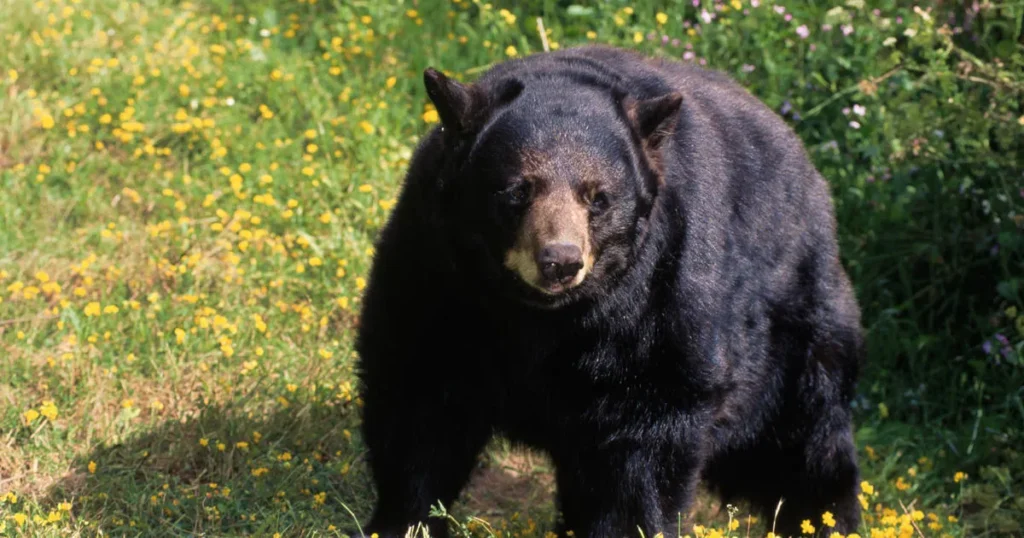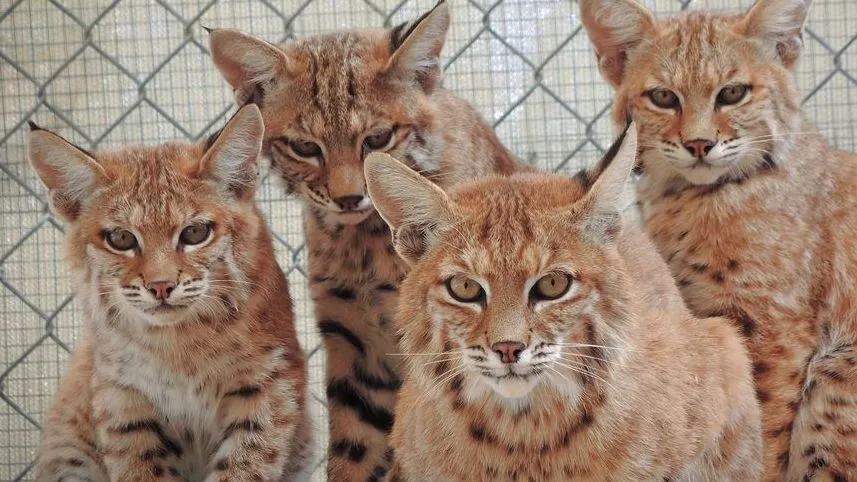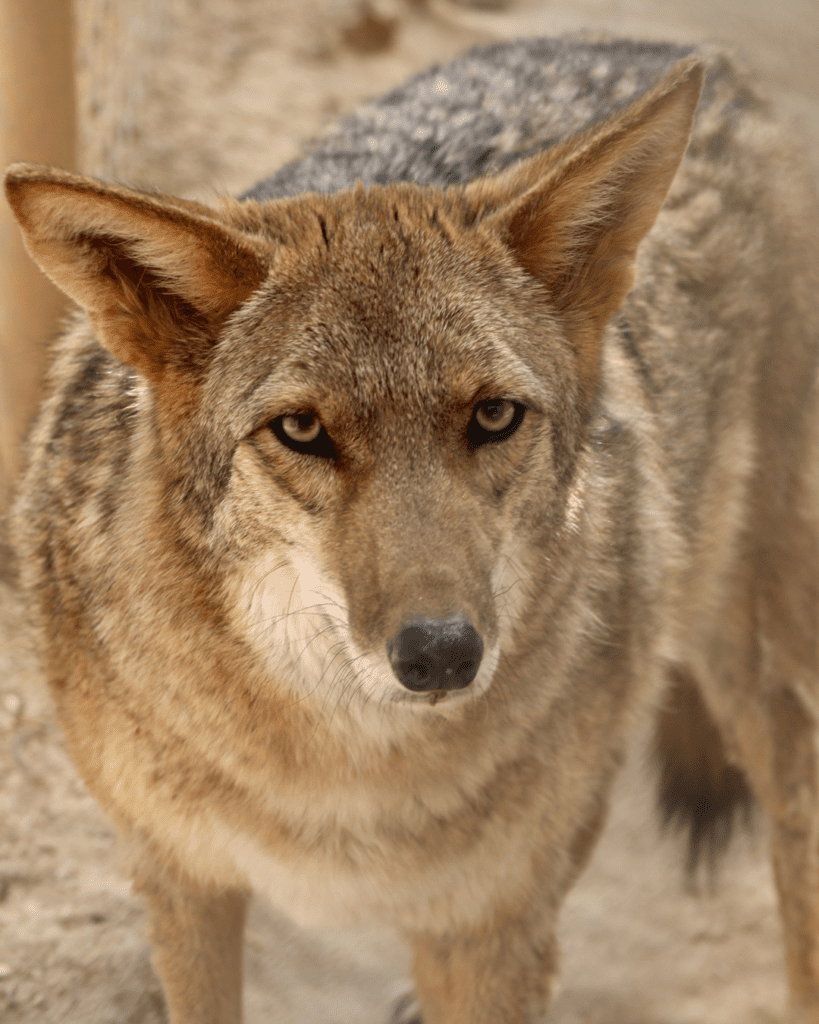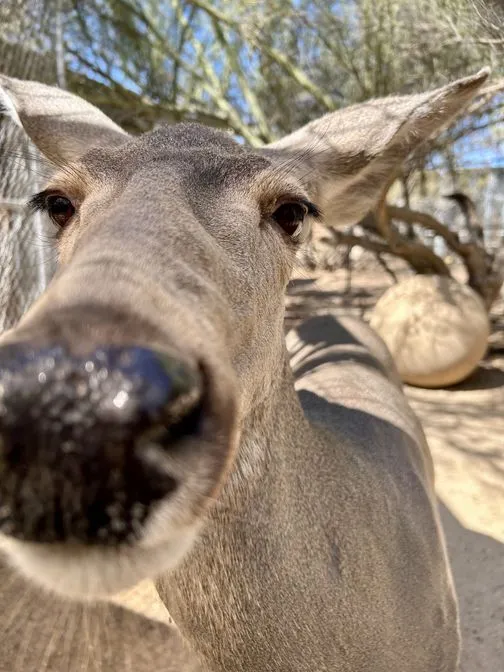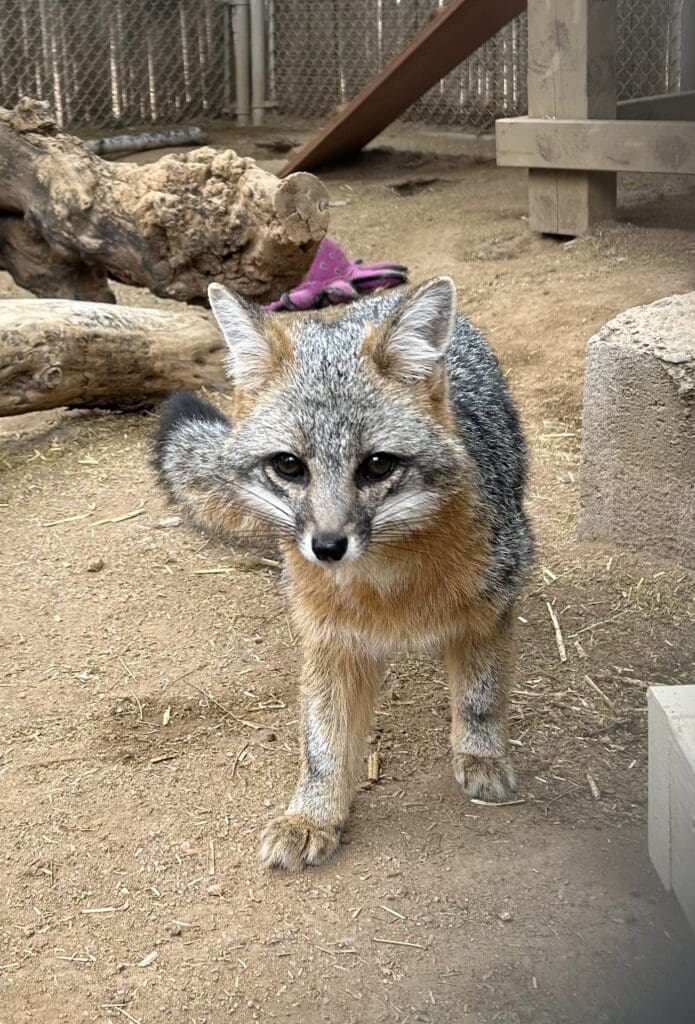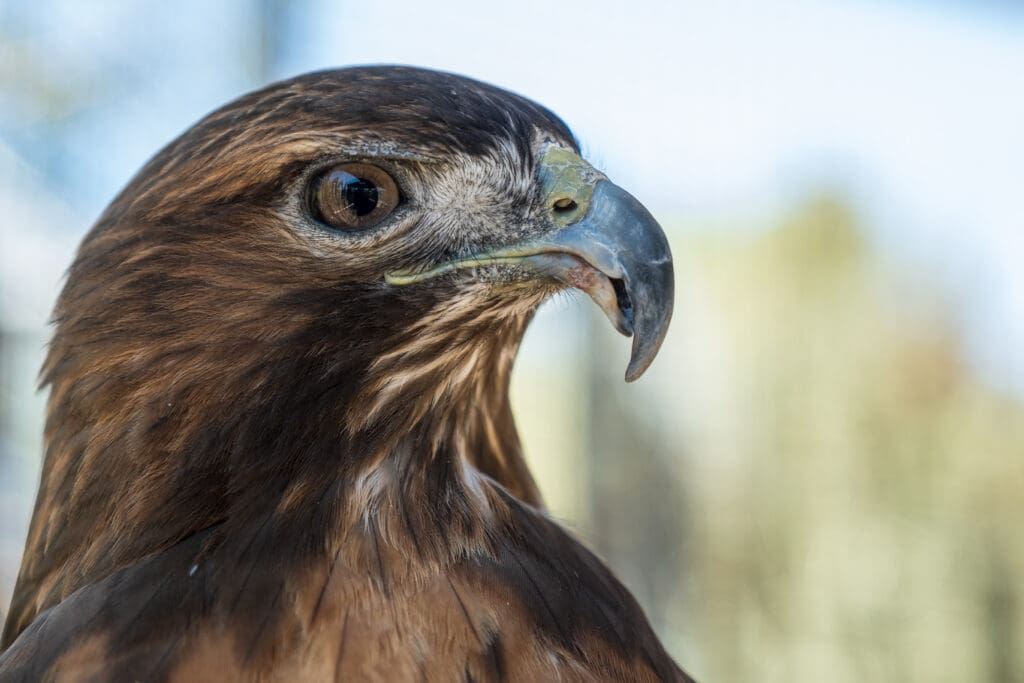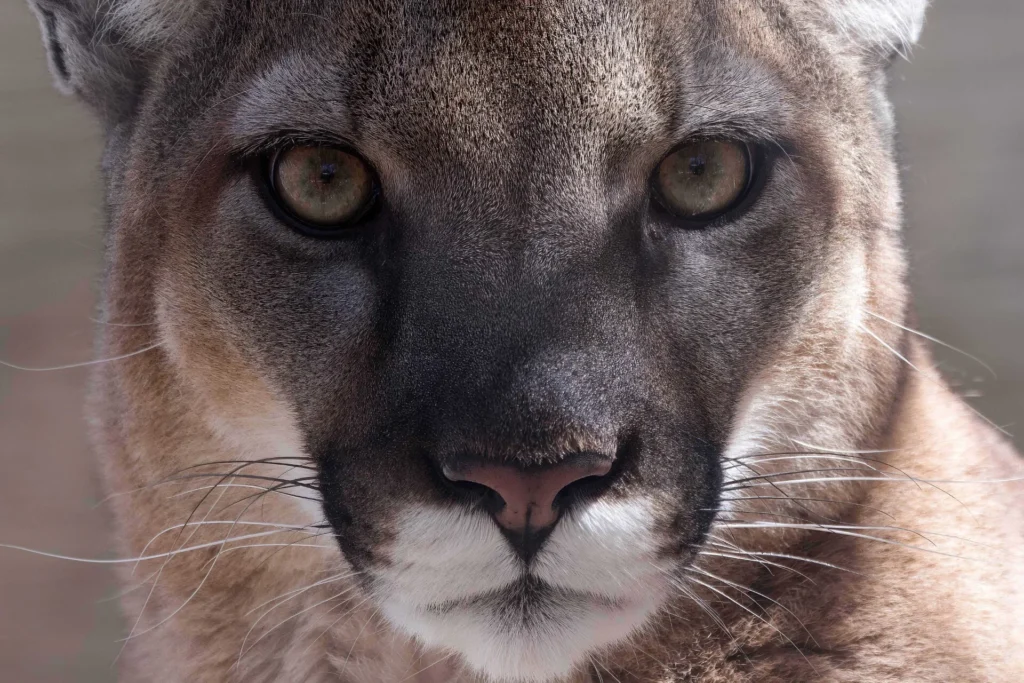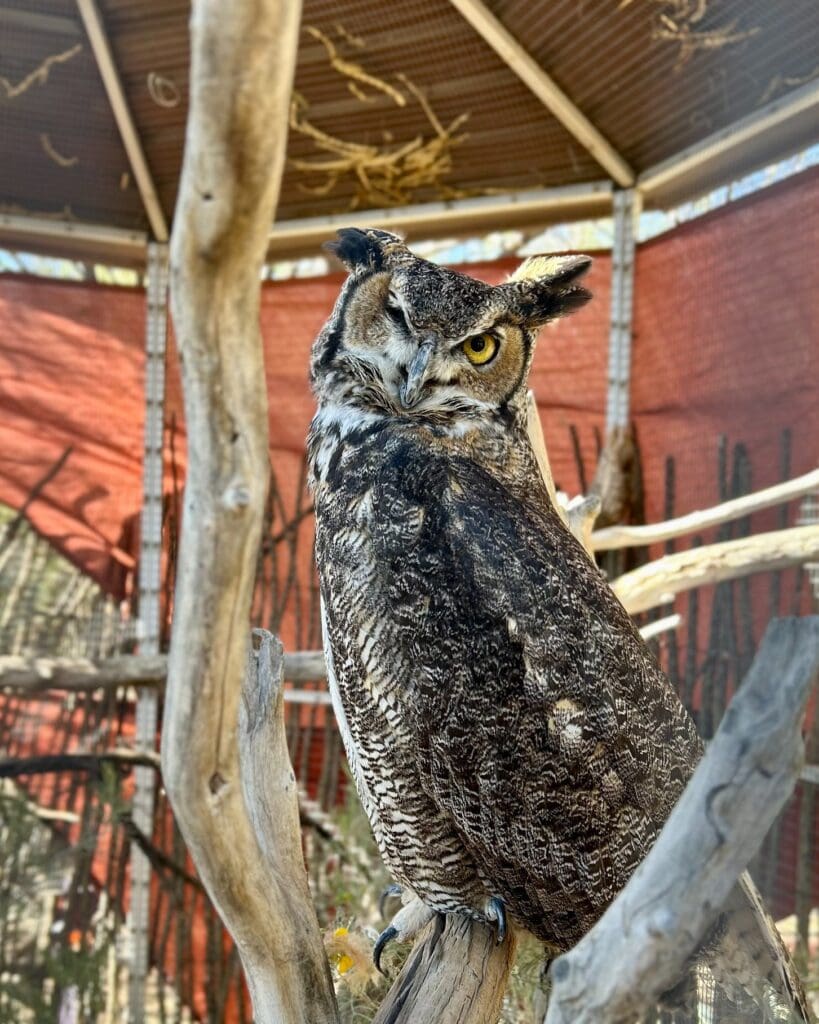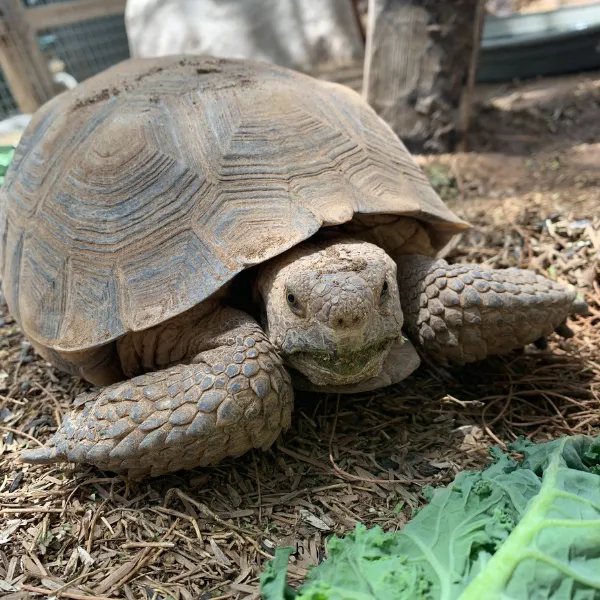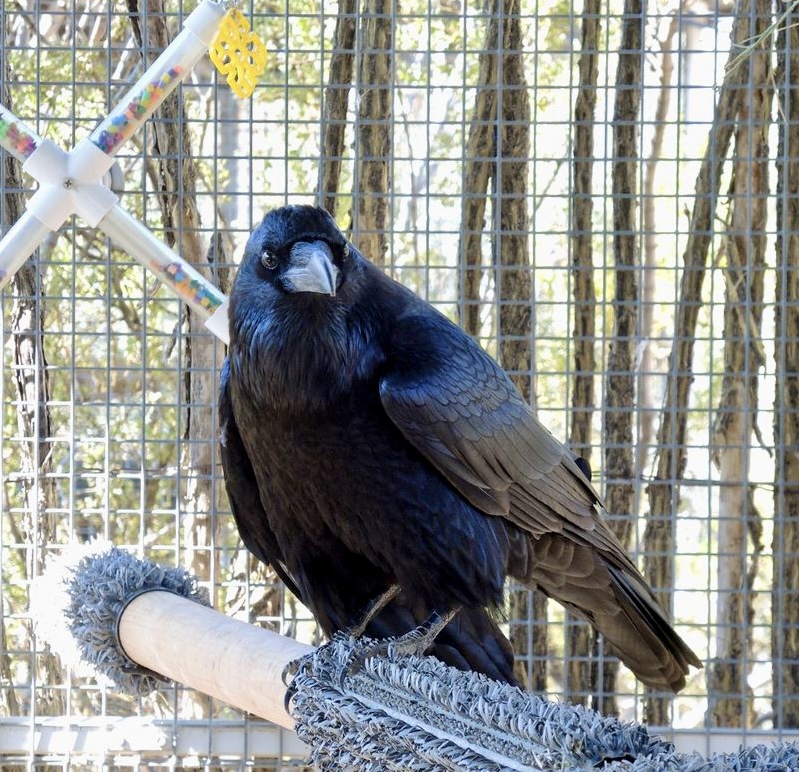Sanctuary Residents
When release is not possible, animals find a lifelong home at our Sanctuary.
Sometimes, an animal that comes to Southwest Wildlife is not able to return to the wild. This could be due to an injury, disability or because they were kept as pets and never learned how to survive on their own. Others were orphaned or abandoned and never had the chance to learn wild behaviors from their parents.
Southwest Wildlife is a proud partner in the Mexican Wolf Species S.A.F.E. (Saving Animals From Extinction) Program, helping to protect one of the rarest subspecies of gray wolf. As a holding facility, we provide space, food, and care for part of the managed population, entirely at our own expense, with no state or federal funding.
Between our Sanctuary residents and Mexican Gray Wolves, Southwest Wildlife has approximately 70 animals on our tour route.
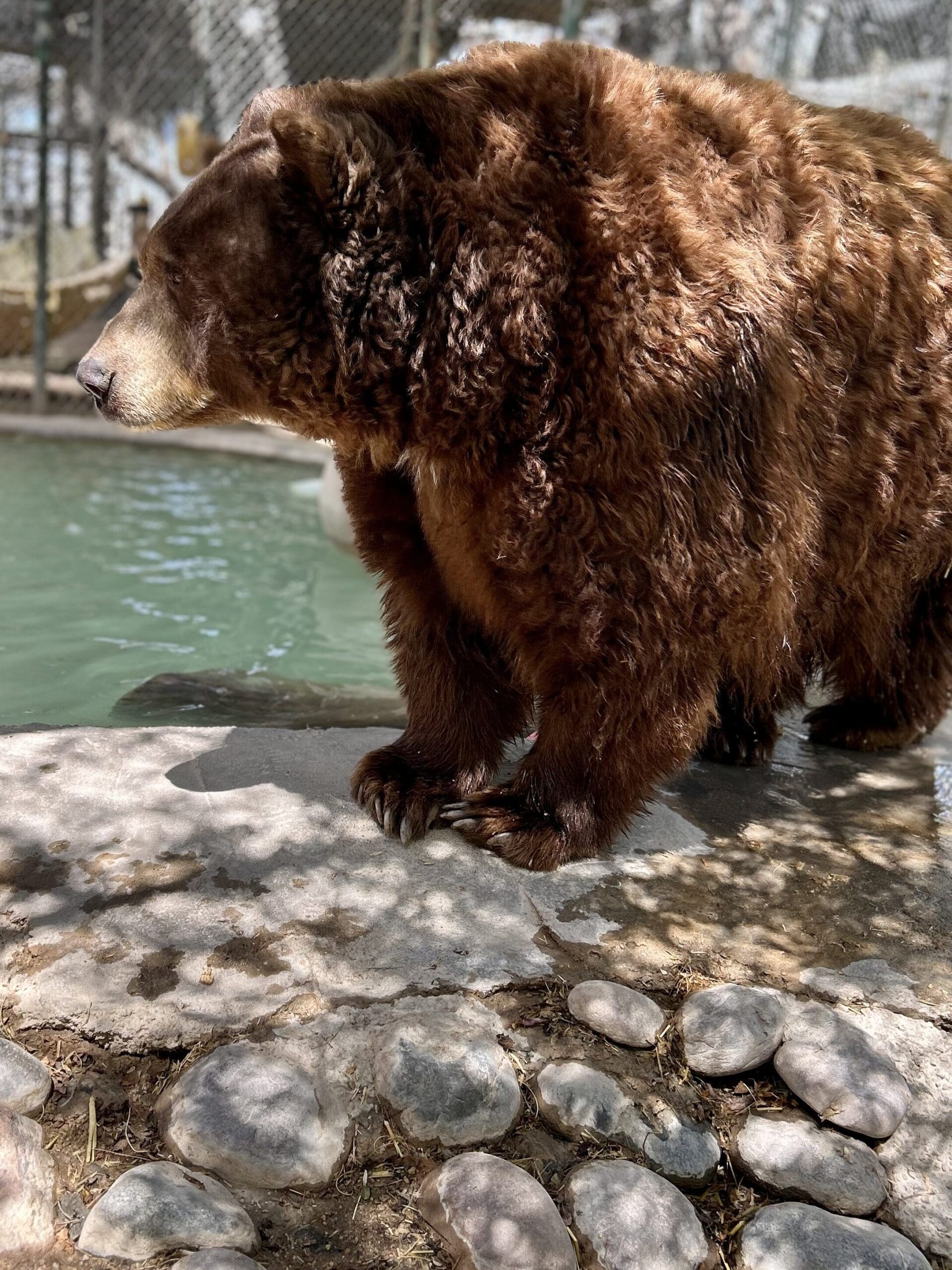
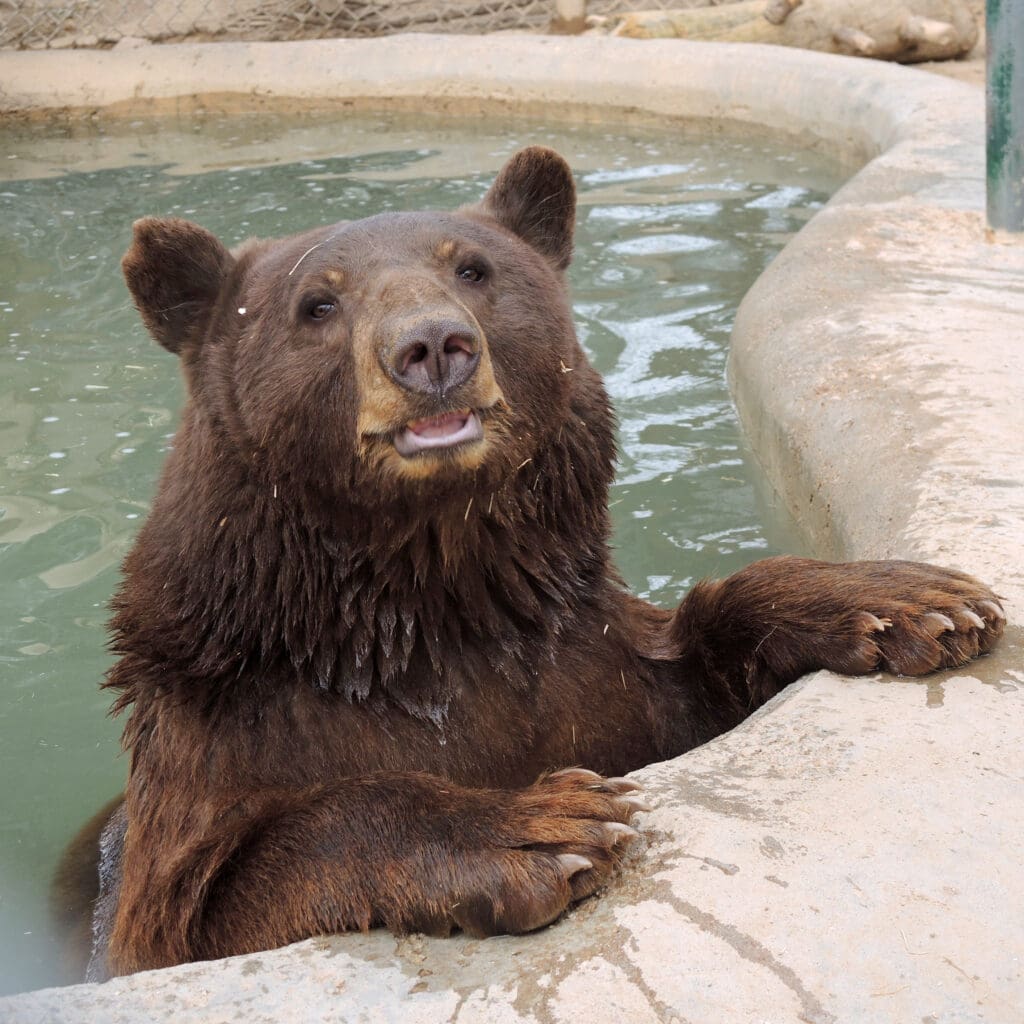
YOUR SUPPORT GIVES ANIMALS WHO CANNOT RETURN TO THE WILD LIFELONG SANCTUARY
Heavenly Bear Found Sanctuary Care at SWCC in 2014.
Sanctuary Wildlife
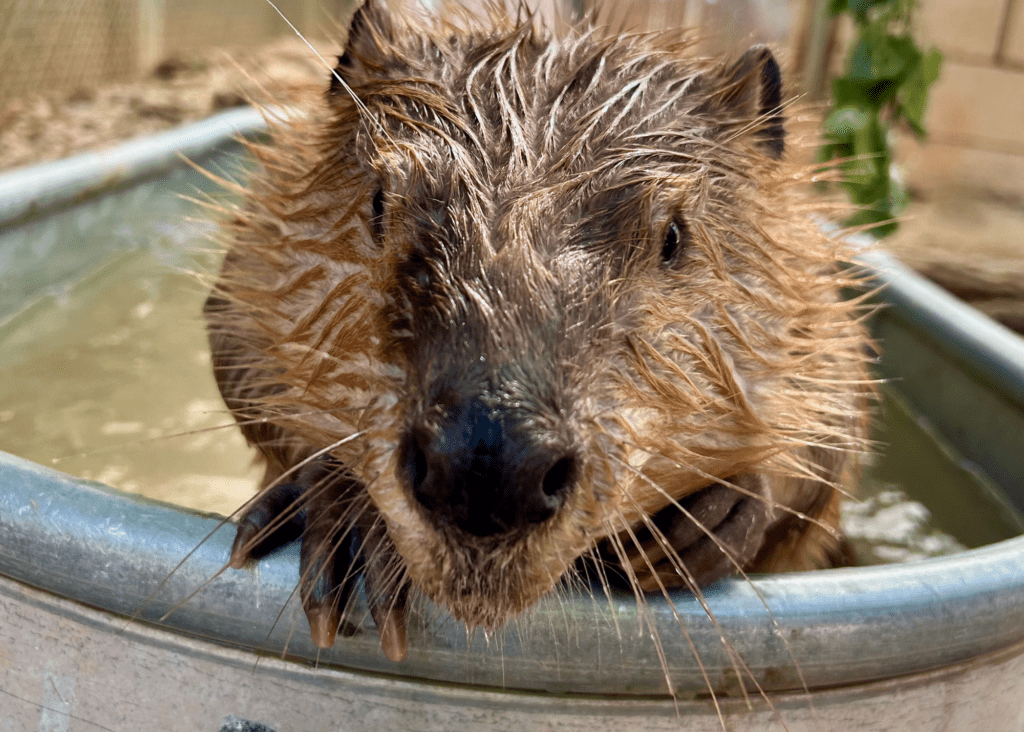
Castor canadensis
- Habitat: Ponds, lakes, rivers, marshes, streams and adjacent wetland areas.
- Status: Least concern
- Population Trend: Stable
- Diet: Bark and cambium (the softer growing tissue under the bark of trees). Their favorites include willow, maple, poplar, beech, birch, alder, and aspen trees. They also eat water vegetation, as well as buds, and roots
- Weight: 25 – 70 lbs.
- Size: 1′ – 1.5′ tall, 2.5′ – 3′ long
- Lifespan: 10 – 12 years in the wild; up to 20 in human care
- Interesting Facts:
- Cellulose, which usually cannot be digested by mammals, is a major component of the American Beaver
- Beavers are one of the few animals that modify their habitat; they build watertight dams of sticks woven with reeds, branches and saplings, which are caulked with mud.
- The American beaver lives in marshy areas which slow down water streams in case of a flood. The beaver hinders soil erosion and promotes water level rise. Sludge occurs upstream of the dikes thus putting toxins out of action. Ponds start to grow from water, supported by dams, after which lilies appear. And then, when the lodges are left by beavers, eventually the dams start decaying, giving way to meadows.
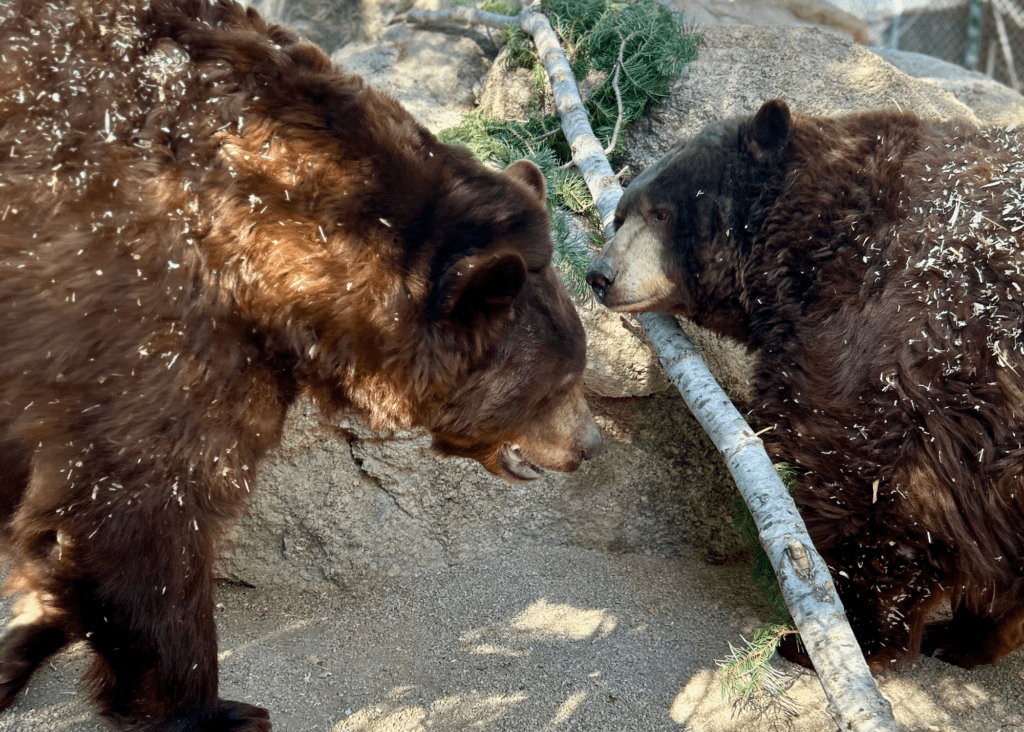
Ursus americanus
- Habitat: Forests, subalpine meadows, and desert riparian areas
- Status: Least concern
- Population Trend: Increasing
- Diet: Though classified as a carnivore, black bears have an omnivorous diet including roots, berries, meat, fish, insects, larvae, grass, and other succulent plants.
- Weight: Up to 350 lbs. for males, up to 250 lbs. for females
- Height: 3′ at the shoulder, 5′ – 7′ standing
- Lifespan: As they have no known predators other than humans, in the wild bears can reach 20 – 25 years; up to 30 in human care
- Interesting Facts:
- Considered a “master dozer” among bear species, black bears hibernate for ~100 days (depending on the region in which they live), during which the cubs are born.
- Black bears aren’t always black. They can be brown, blonde, red, even a bluish-gray.
- Black bears have a very keen sense of smell and can smell up to 20 miles away.
Read Heavenly’s story and become a sponsor
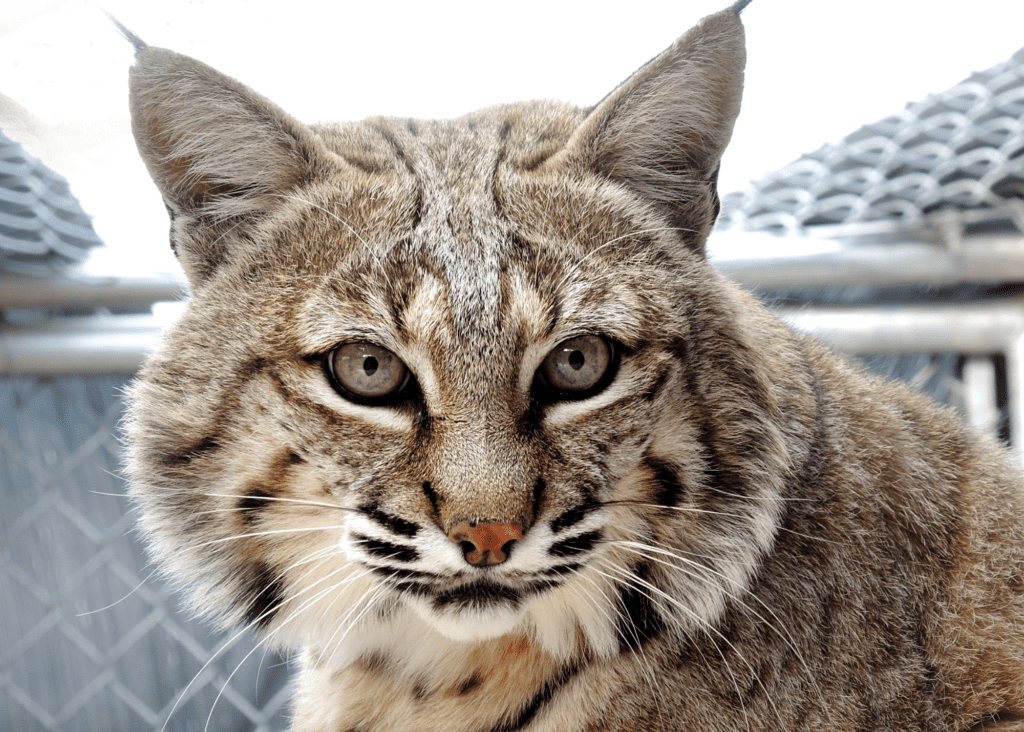
Lynx rufus
- Habitat: Deserts, sage brush, riparian woodlands, coniferous forests, broadleaf forests, chaparral swamp – even suburban areas.
- Status: Least concern
- Population Trend: Stable
- Diet: An obligate carnivore, their food of choice is rabbit, but they will eat birds, rodents, lizards, snakes, and carrion
- Weight: 15 – 30 lbs.
- Height: 20″ tall; 2′ – 2.5′ in length
- Lifespan: 10 – 13 years in the wild; up to 25 years in human care
- Interesting Facts:
- The black and white marks on the backs of a bobcat’s ears are “false eyes”. False eyes are common in nature and appear on all kinds of animals, from birds to butterflies. They are meant to deceive potential predators to look like an animal with larger eyes are looking at them.
- Bobcats are the most abundant species of wildcat in the United States.
- The bobcat is often confused with its cousin, the lynx, as both share a tannish brown coat with dark spots or lined markings. The differences between the two species are in the details. Bobcats have short, pointy dark tufts of hair on the tops of their ears and fluffy tufts of hair on their cheeks. Bobcats also have short, bobbed tails that are four to seven inches in length.
Read Catalina’s story and become a sponsor
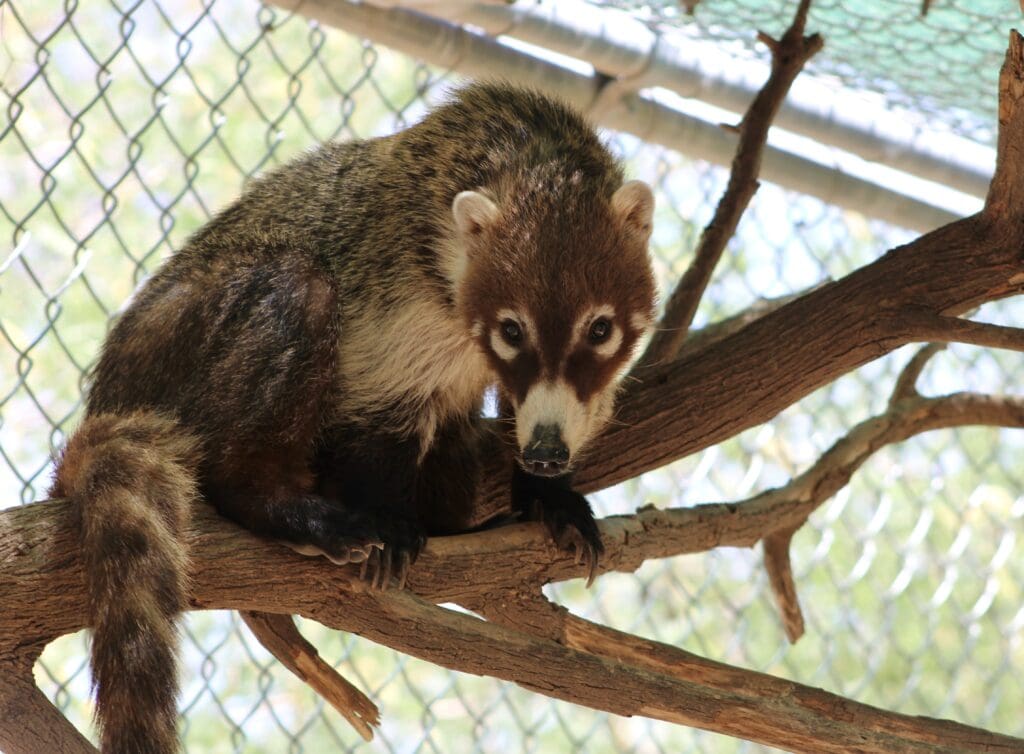
Nasua narica
- Habitat: Dry high-altitude forests to tropical lowlands and the desert
- Status: Least concern
- Population Trend: Decreasing
- Diet: Omnivore; highly varied consisting of small vertebrate prey (lizards, rodents, birds, bird eggs), also ground-litter invertebrates like flatworms, roundworms, and grubs
- Weight: 4 – 16 lbs.
- Height: 12″ at the shoulder; 13″ – 27″ long, with a tail almost as long as their body
- Lifespan: 7 years in the wild; up to 16 years in human care
- In the Southwest Wildlife Sanctuary: 3
- Interesting Facts:
- The coatimundis’ ankles are double jointed and extremely flexible, enabling them to descend trees head first.
- The term “Coati” means lone coatimundi.
- Coatimundis’ tail is considered nonprehensile. Their tails cannot help them climb trees or hang from branches but is rather for balance as they walk among the trees
Read Chi’s story and become a sponsor
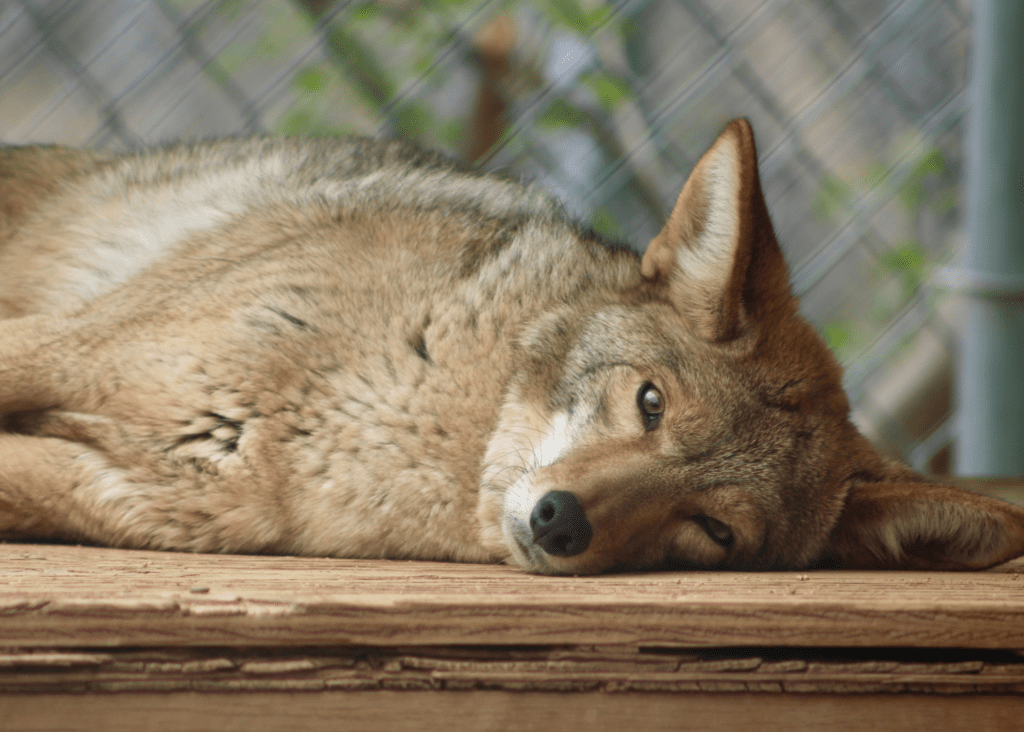
Canis latrans
- Habitat: Desert scrub, grasslands, foothills, forests – even populated cities.
- Status: Least concern
- Population Trend: Increasing
- Diet: True omnivores who eat a variety of foods including rodents, rabbits, insects, lizards, snakes, vegetables, and fruit
- Weight: 20 – 40 lbs.
- Height: 21″ – 24″ tall; 32″ – 37″ long
- Lifespan: 10 – 15 years in the wild; up to 20 years in human care
- Interesting Facts:
- Coyotes can run up to 40 mph and jump 14 feet in the air.
- Coyotes are found in 49 states in the United States with Hawaii being the only state they do not inhabit.
- Coyotes can dig dens up to 10 feet deep.
Read Ziggy’s story and become a sponsor
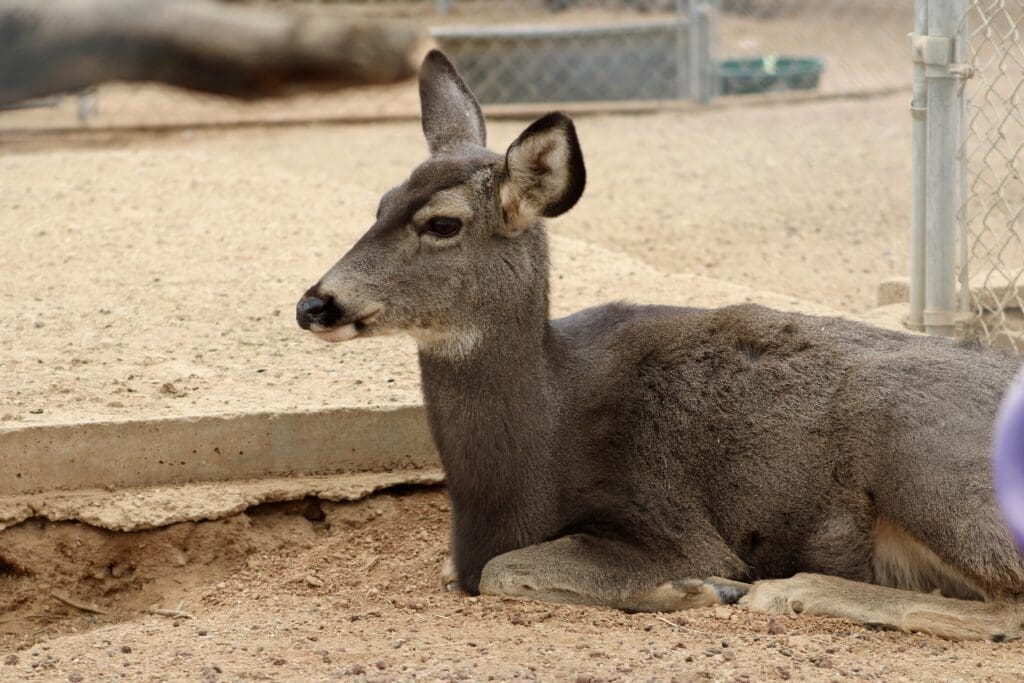
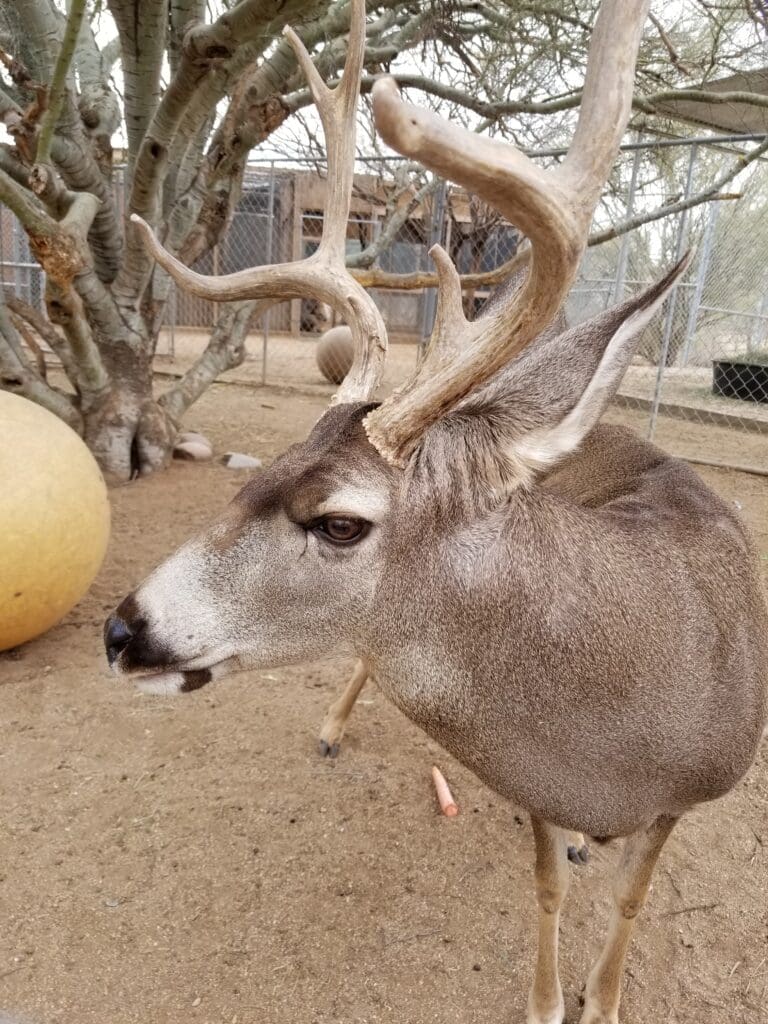
Coues Deer, Odocoileus virginianus
- Habitat: Mountain forests, wooded hills, chaparral, and desert regions
- Status: Least concern
- Population Trend: Stable
- Diet: These “browsers” are herbivores, feeding on a variety of vegetation from fruits and seeds to grasses and leaves
- Weight: 100 – 150 lbs. Females are smaller than males
- Size: 2′ – 2.5′ tall; 5′ – 7′ long
- Lifespan: 6 – 9 years in the wild; up to 18 years in human care
- Interesting Facts:
- The annual cycle of antler growth is regulated by the changes in the length of the day. Their antlers will typically shed in the months of January-March and start growing again in the Spring.
- Coues deer are a subspecies of Whitetail Deer.
- “White-tailed” refers to the white underside of the deer’s tail, which it displays and wags when it senses danger.
Mule Deer, Odocoileus hemionus
- Habitat: Mountain forests, wooded hills, chaparral, and desert regions
- Status: Least concern
- Population Trend: Stable
- Diet: These “browsers” are herbivores, feeding on a variety of vegetation from fruits and seeds to grasses and leaves.
- Weight: 130 – 280 lbs. Females are smaller than males
- Size: 3′ – 3.5′ tall; 4.5′ – 7′ long
- Lifespan: 9 – 11 years in the wild; up to 25 years in human care
- Interesting Facts:
- The annual cycle of antler growth is regulated by the changes in the length of the day. Their antlers will typically shed in the months of January-March and start growing again in the Spring.
- Mule Deer get their name after their ears, which are large like a mule.
- Mule Deer can jump 15 feet in length.
Read Lou’s story and become a sponsor
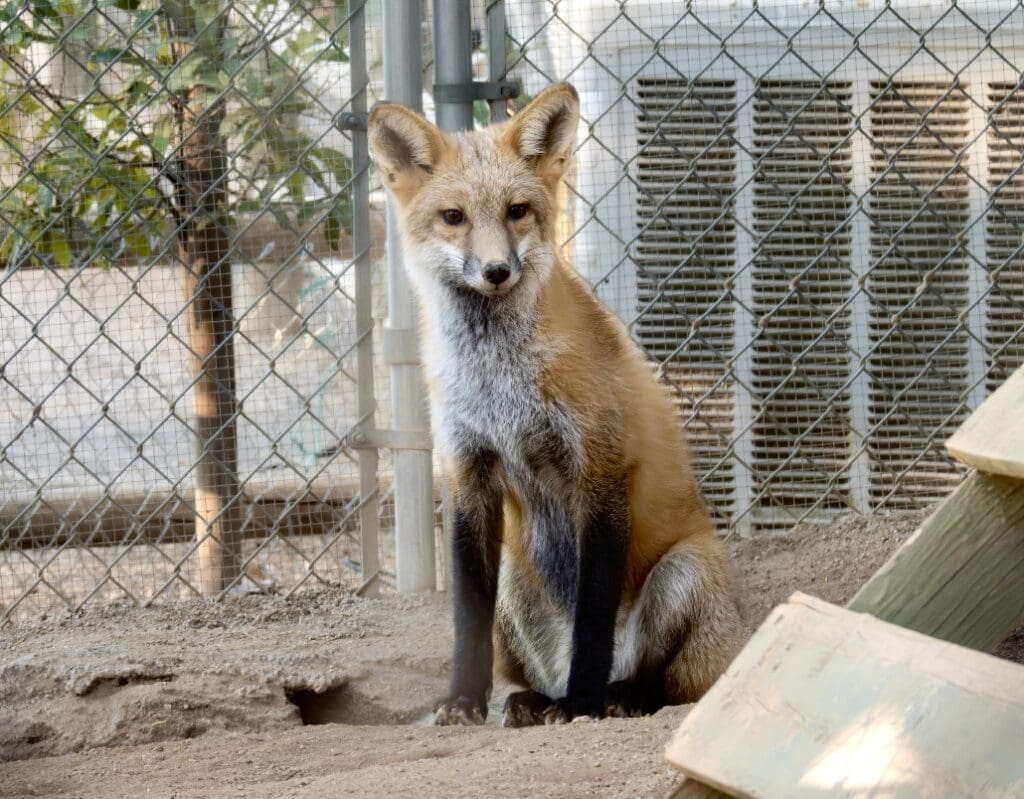
Gray Fox, Urocyon cinereoargenteus
- Habitat: Chaparral, wooded areas, mountains, canyons, denser brush, slopes of rocky ridges, and desert landscape
- Status: Least concern
- Population Trend: Stable
- Diet: Omnivores that vary preference depending on seasonal availability which include rodents, birds, eggs, worms, etc
- Weight: 7 – 14 lbs.
- Size: 12″ – 16″ tall; 35″ – 41″ long
- Lifespan: 6 – 10 years in the wild; up to 20 years in human care
- Interesting Facts:
- The Gray fox is one of only two canine species known to regularly climb trees.
- Gray foxes are the medium size of the 3 species of fox we have here in Arizona.
- Gray foxes are considered to be more nocturnal than red or kit foxes.
Red Fox, Vulpes vulpes
- Habitat: Grasslands, deserts, thick forests, icy planes, and even urban areas
- Status: Least concern
- Population Trend: Stable
- Diet: Omnivores that vary preference depending on seasonal availability which include rodents, birds, eggs, worms, etc
- Weight: 6.5 – 15 lbs.
- Size: 13.8″ – 19.7″ tall; 17.7″ – 35.4″ long
- Lifespan: 2 – 6 years in the wild; 10 – 14 years in human care
- Wild population in Arizona: Unspecified
- In the Southwest Wildlife Sanctuary: 4
- Interesting Facts:
- A red fox’s tail measures about 1/3 of its length. In cold weather it serves as warm cover. It also serves as a signal flag to communicate with other foxes.
- Two variant colorations live in the Southwest Wildlife Sanctuary: marble and silver. Look at the picture at the bottom of the page to see examples of how red foxes aren’t always red!
- Red foxes are the largest of the 3 species of fox we have here in Arizona.
Kit Fox, Vulpes macrotis
- Habitat: Deserts, desert edges, chaparral, scrub, savanna, grasslands, sand dunes
- Status: Least concern
- Population Trend: Decreasing
- Diet: Omnivores that vary preference depending on seasonal availability which include rodents, birds, eggs, worms, etc.
- Weight: 3.5 – 6 lbs.
- Size: 10″ – 12″ tall; 17″ – 21″ long
- Lifespan: Up to 7 years in the wild; up to 12 years in human care
- Wild population in Arizona: Unspecified
- In the Southwest Wildlife Sanctuary: 1
- Interesting Facts:
- In relation to their body, kit foxes have massive ears for improved thermoregulation – and of course, hearing.
- Kit foxes are the smallest of the 3 species of fox we have here in Arizona.
- Kit foxes do not drink any water in the wild. They get their water intake from rodents they eat! However, if there is a water source nearby, they will drink from it.
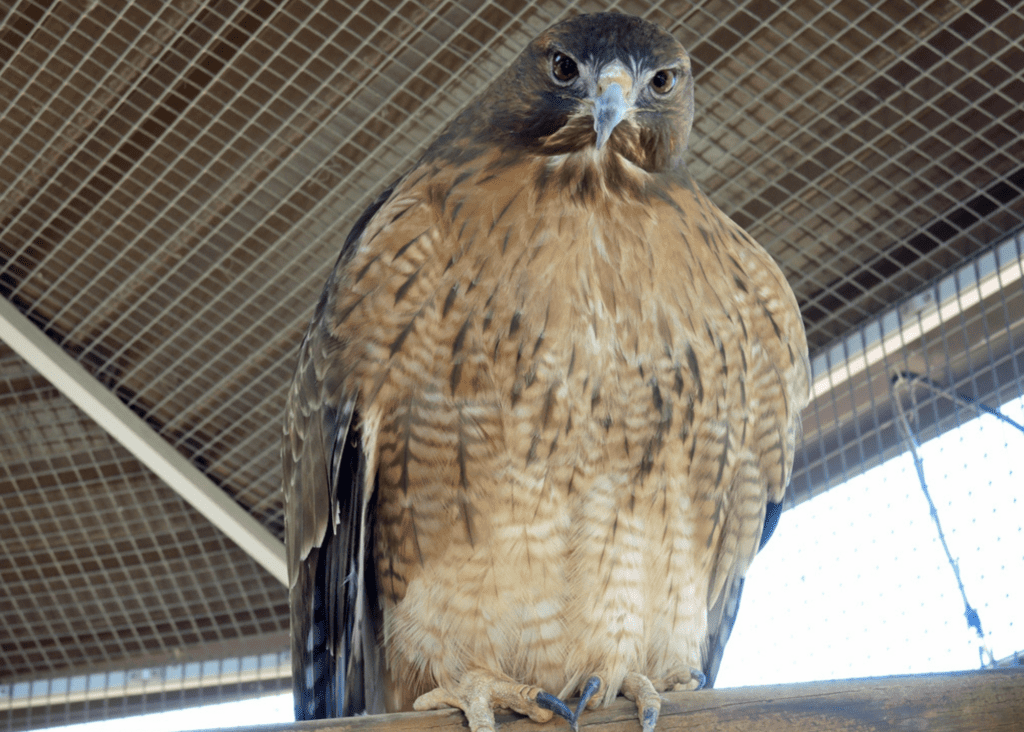
Red Tailed Hawk, Buteo jamaicensis
- Habitat: Open fields especially near woodlands, grasslands, marsh-shrub, and urban areas
- Status: Least concern
- Population Trend: Increasing
- Diet: These carnivorous birds eat small mammals, birds, rabbits, lizards, snakes, and more
- Weight: 1.5 – 3.5 lbs.
- Height: 18″ – 26″ body; 43″ – 55″ wingspan
- Lifespan: 6 – 10 years in the wild; 25 – 35 years in human care
- Interesting Facts:
- The red-tailed hawk is one of the few birds capable of “kiting,” holding still against the wind on set wings, much like a kite tugging against a string.
- Red Tailed Hawks are the most common large hawk that can be found in every U.S state and almost all habitats.
- Red Tailed Hawks have 8 times better eyesight than humans.
Harris Hawk, Parabuteo unicinctus
- Habitat: Sparse woodland, semi-desert as well as some marshes
- Status: Least concern
- Population Trend: Stable
- Diet: These carnivorous birds eat small mammals, birds, rabbits, lizards, snakes, and more
- Weight: Males are 1.5 lbs, Females are larger at around 2 lbs.
- Height: 18″ – 23″ body; 41″ – 47″ wingspan
- Lifespan: 10 – 12 years in the wild; 20- 25 years in human care
- Wild population in Arizona: Unspecified
- In the Southwest Wildlife Sanctuary: 1
- Interesting Facts:
- Harris’s hawks are the only birds of prey that hunt in groups. Such unique behavior has earned them the nickname “wolves of the sky.”
- Harris’s hawks practice a behavior known as “back-standing”. Several birds will stand on top of each other.
- Harris’s Hawks remember everything and so they learn how to capitalize and how to use people in assisting them in their abilities to hunt and catch food for themselves. They are considered to be one of the smartest birds of prey.
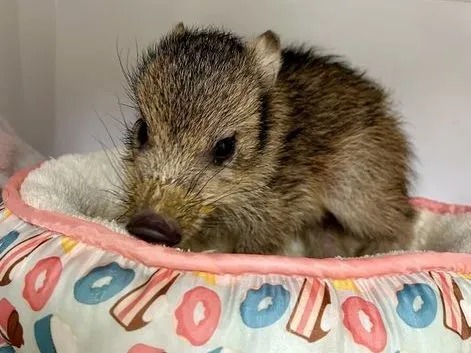
Pecari tajacu
- Habitat: Desert washes, saguaro and Palo Verde forests, oak woodlands and grasslands with mixed shrubs and cacti
- Status: Least concern
- Population Trend: Stable
- Diet: Herbivores who eat a wide variety of native plants such as agave, mesquite beans, prickly pear, as well as roots, tubers, and other green vegetation. However, if the opportunity presents itself, they will also eat lizards, dead birds, and rodents
- Weight: 35 – 55 lbs.
- Size: 2′ tall; 3′ – 4′ long
- Lifespan: 10 years in the wild; up to 20 years in human care
- Interesting Facts:
- “You can smell them before you see them.” Javelina have a scent gland on top of their rump. They will rub their scent on rocks and tree stumps to mark their territory, as well as each other to help identify family members.
- Javelina hair is modified to be very coarse and thick. This modification helps them move in the pokey spines of a cactus as they forage for prickly pears.
- Javelina are more closely related to Hippos and Camels as they are to Pigs.
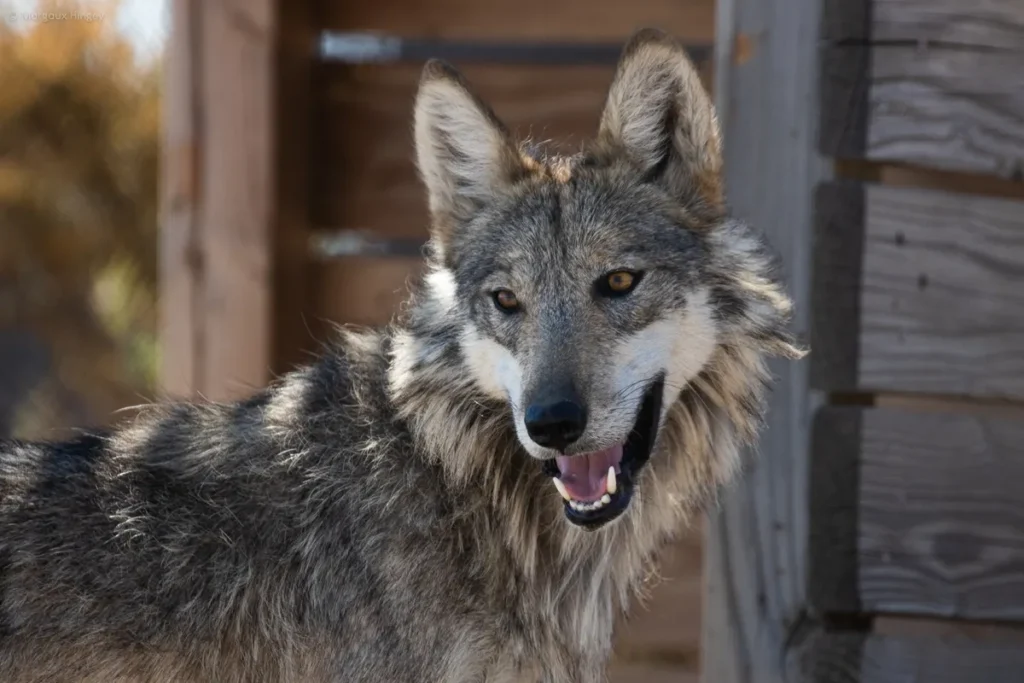
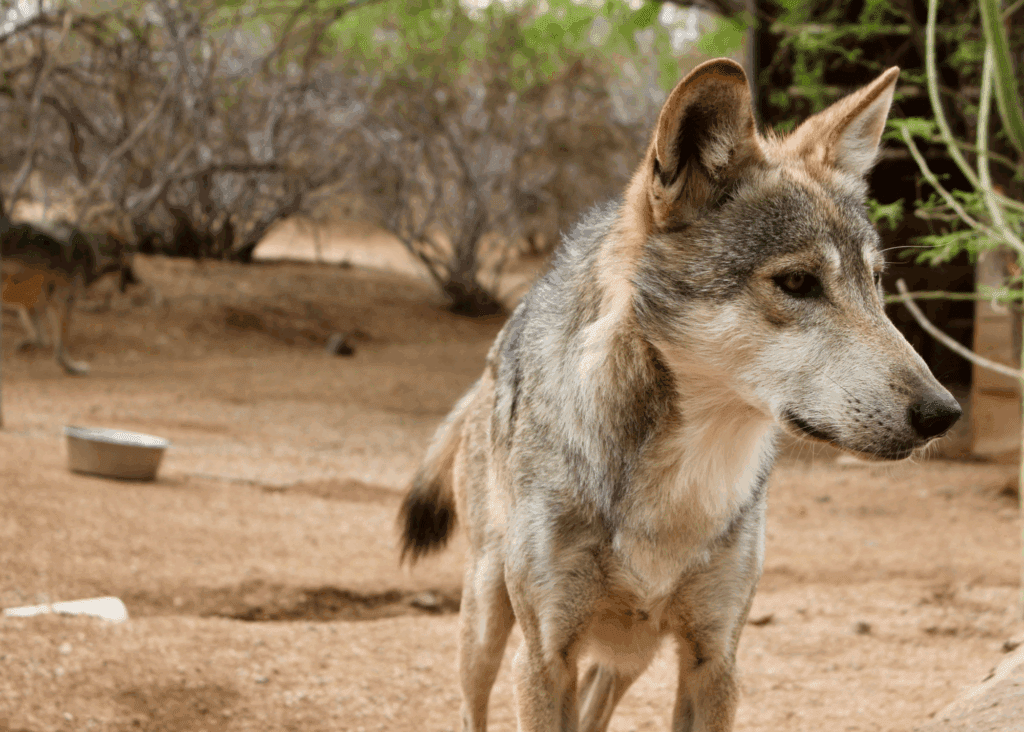
Canis lupus baileyi
- Habitat: Native only to Arizona, New Mexico, and Mexico, Mexican gray wolves live in mountainous forests, woodlands, and desert
- Status: Critically endangered
- Population Trend: Increasing
- Diet: Wolves are carnivores who eat primarily ungulates (hoofed animals) like deer, moose, and elk. To survive, they will also eat smaller animals like hares, beavers, and rodents
- Weight: 60 – 85 lbs. Males are larger than females
- Size: 26″ – 31″ tall; 3.9′ – 4.9′ long
- Lifespan: 6 – 8 years in the wild; up to 16 years in human care
- Interesting Facts:
- The Mexican gray wolf is the smallest, southernmost, and most genetically distinct subspecies of gray wolf in North America.
- Southwest Wildlife is a long-standing member of Saving Animals From Extinction (SAFE), for this subspecies of the gray wolf. We have contributed to the preservation of this rare wolf by offering space at our sanctuary to care for part of the captive population. As a holding facility, Southwest Wildlife covers the entire expense of feeding and caring for these animals, with no contribution from either Federal or State agencies.
Read Vera’s story and become a sponsor
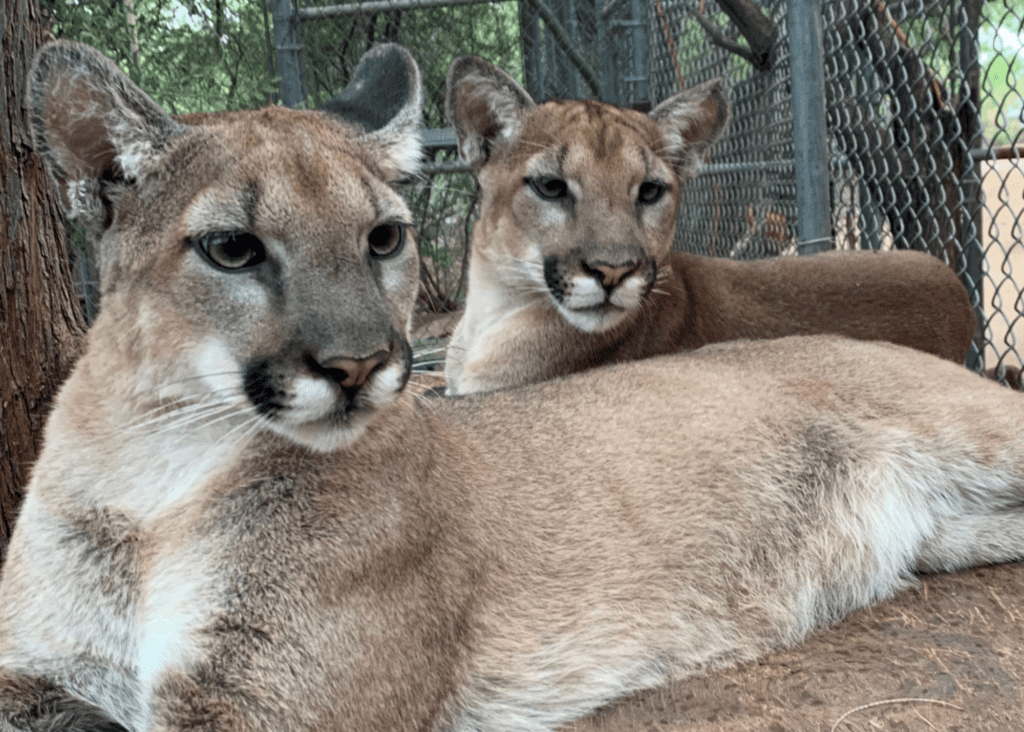
Puma concolor
- Habitat: Desert and forested mountains with broken terrain and steep slopes
- Status: Least concern
- Population Trend: Decreasing
- Diet: These obligate carnivores are ambush hunters. Mountain lions will eat elk, deer, coyotes, raccoons, small mammals, and even porcupines
- Weight: 90 – 150 lbs. Males are larger than females
- Size: 24″ – 35″ tall at the shoulders; 6.7′ – 7.9′ long. Their tails account for 25-35% of their body length
- Lifespan: 8 – 10 years in the wild; up to 20 years in human care
- Interesting Facts:
- Mountain lions are in the Guinness Book of World Records for the animal with the most common names. 40!
- Mountain lions’ tails are used like boat rotors. They can shift their tails from left to right at top speed to change their direction very quickly when chasing prey.
- Mountain lions can jump 40 feet. The length of a school bus!
Read Felix and Zia’s story and become a sponsor
Common Barn Owl, Tyto alba
- Habitat: Barn owls often gravitate toward open areas, like prairies or farmlands, but can be found in a wide variety of habitats, including developed urban areas
- Status: Least concern
- Population Trend: Stable
- Diet: Rodents and other small mammals – predominantly voles, mice and shrews – and very occasionally bats, small birds, amphibians and invertebrates
- Weight: 8 oz – 25 oz
- Size: 13″ – 15″ long; 31″ – 37″ wingspan
- Lifespan: 2 – 4 years in the wild; up to 25 years in human care
- Interesting Facts:
- Barn Owls make eerie screeching and hissing noises.
- Barn Owl is silent in flight due to soft fringe-edged feathers that don’t “swoosh” as they move.
- Barn Owls can hear a mouse’s heartbeat in a 30 square foot room!
Great Horned Owl, Bubo virginianus
- Habitat: Found throughout North America, including sub-tundra, woodlands, fields, rain forests, and both rural and urban areas.
- Status: Least concern
- Population Trend: Stable
- Diet: These carnivorous birds eat rodents, rabbits, birds, snakes, lizards, even skunks!
- Weight: 2 – 5 lbs.
- Height: 18″ – 25″ body; 3.3′ – 4.8′ wingspan
- Lifespan: 5 – 15 years in the wild; 20 – 30 years in human care
- Interesting facts:
- While humans have seven neck bones, owls possess 14. This allows them to turn their heads up to 270 degrees. Why do they need to turn their heads that far? Unlike humans, who can move their eyes side to side, and up and down, owls’ eyes are “fixed.” To look at something that isn’t right in front of them, they must turn their whole head.
- Owls do not build their own nests; because they lay eggs earlier in the year than most other species, they use old raven and hawk nests to raise their young
- Great Horned Owls are the second largest owl in North America but the largest in Arizona.
Read Moccasin’s story and become a sponsor
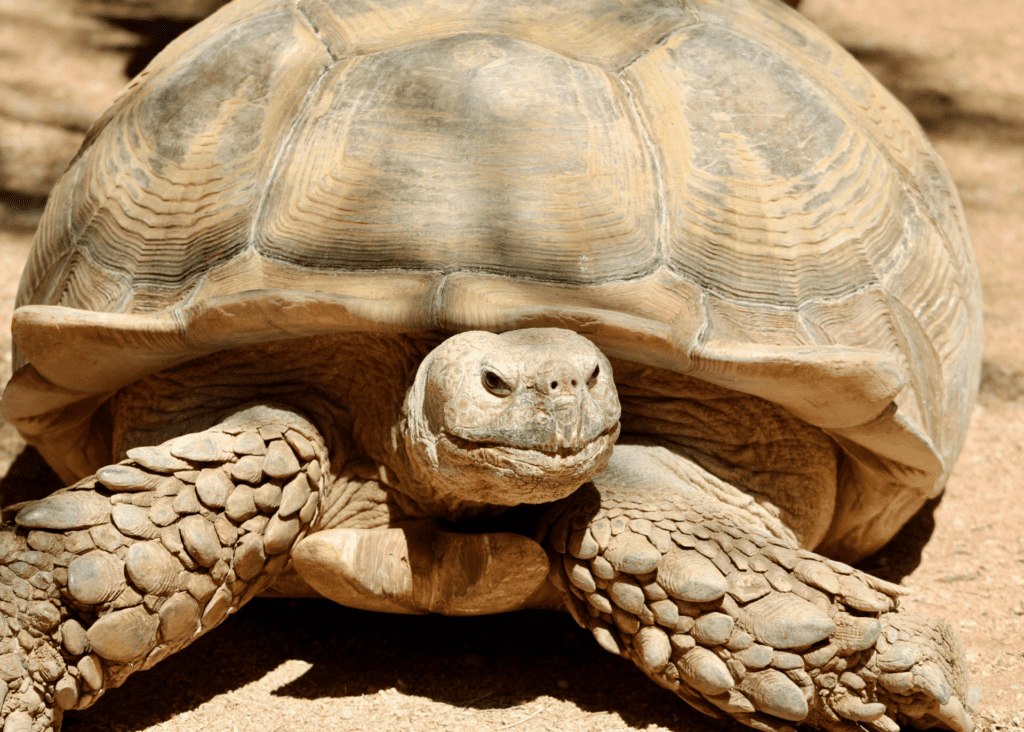
Gopherus morafkai
- Habitat: Desert and semi-desert grasslands
- Status: Threatened
- Population Trend: Decreasing
- Diet: These reptiles are primarily herbivores, and eat grasses, weeds, wildflowers, and leaves. In the Sonoran Desert, they also eat cactus pads and the fruit from various cacti. Occasionally, a tortoise may even eat bone material scavenged from mammal scat as a means of obtaining calcium
- Weight: 8 – 15 lbs.
- Size: 3.9″ – 5.9″ tall; 9.8″ – 14″ long
- Lifespan: 50 – 80 years
- Interesting Facts:
- A common way tortoises defend themselves is to empty their bladder – urinate – if they are picked up or handled. This could lead to their death if they can’t find water soon thereafter.
- Sonoran Desert Tortoises’ predators include; ravens, gila monsters, kit foxes, badgers, roadrunners and coyotes. They prey on the juveniles, which are 2 to 3 inches long and have thin, delicate shells. Mountain lions may occasionally take adult tortoises.
- You should never return a captive tortoise to the wild because they might not survive (and it is illegal). If you already have a tortoise and can’t keep it, try to find someone else to take care of it. If you can’t find anyone then give it to an adoption program.
Centrochelys sulcata
- Habitat: Deserts and semi-arid regions of North Africa. They are found commonly in grasslands, deserts, savannas, and thorn scrubland
- Status: Endangered
- Population Trend: Decreasing
- Diet: These reptiles are herbivores and eat grasses, weeds, wildflowers, and leaves
- Weight: Females can weigh 80 – 130 lbs. Males are larger at 150 – 200 lbs.
- Size: Around 15″ tall; 24″ – 30″ wide; 25″ – 30″ long
- Lifespan: 50 – 150 years
- Wild population in Arizona: Unspecified
- In the Southwest Wildlife Sanctuary: 1
- Interesting Facts:
- When a sulcata tortoise gets thirsty, they can drink up to 15% of their body weight in water!
- The name “sulcata” is a Latin word for “furrow,” which is found on the tortoise’s back between each scute.
- These reptiles find relief from the desert heat by digging burrows up to 10 feet deep.
Read Goliath’s story and become a sponsor
Chihuahuan Raven, Corvus cryptoleucus
- Habitat: Arid grasslands and desert scrub
- Status: Least Concern
- Population Trend: Stable
- Diet: Large insects, cultivated crops, garbage, eggs and young of other birds, fruit
- Weight: 1 – 2 lbs.
- Size: 1.5′ – 1.7′ long; 3.5′ wingspan
- Lifespan: 8 – 15 years in the wild; 30 – 40 years in human care
- Interesting Facts:
- Unlike most crows and ravens, the Chihuahuan Raven frequently reuses its nest in subsequent years. Some pairs may maintain two nests and use them in alternate years.
- The oldest recorded Chihuahuan Raven was at least 21 years, and 9 months old when it was caught and released in Arizona in 2001.
- Chihuahuan Ravens are often more sociable than Common Ravens, and flocks of up to several hundred may be seen soaring over the plains on warm winter days, or scavenging at garbage dumps.
Bassariscus astutus
- Habitat: The ringtail prefers to live in rocky habitats associated with water. These areas can include riparian canyons, caves, and mine shafts.
- Status: Least concern
- Population Trend: Unknown
- Diet: Ringtails are omnivores which means they will eat just about anything if it is the right size. Some of their food choices are fruit, insects, lizards, snakes, small mammals such as mice, woodrats, and squirrels, as well as birds and bird eggs
- Weight: 1 – 2 lbs.
- Size: 6″ – 7″ tall at ; 24″ long. Their tails account for ~50% of their body length
- Lifespan: 6 – 9 years in the wild; up to 14 years in human care
- Interesting Facts:
- Ringtails are excellent climbers capable of ascending vertical walls, trees, rocky cliffs, and even cacti. They can rotate their hind feet 180 degrees, giving them a good grip for descending those same structures.
- In August 1986 the ringrail became the State Mammal of Arizona.
- Ringtails are sometimes wrongly called ringtail-cats or miners cats. They are not related to cats at all. Their relatives include the coati and the raccoon.

